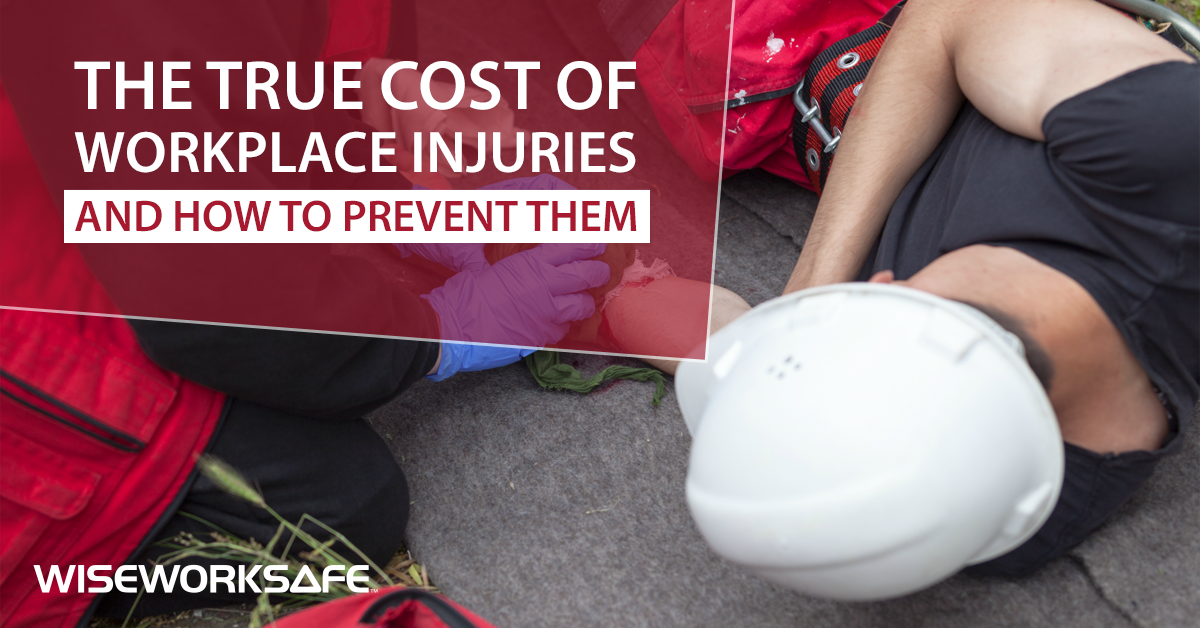Originally published on 25th September 2017
Updated 28th October 2019

The True Cost of Workplace Injuries — and How to Prevent Them
The large majority of us think of cheesy solicitor advertisements when someone refers to “workplace injuries”. Nonetheless, the Health and Safety Executive (HSE) found that 555,000 people sustained a non-fatal injury at work in 2017/18, and 144 workers died.
Workplace injuries cause much personal anguish — whether you have lost a loved one or suffered an injury yourself. But statistics show the cost of workplace injuries to the economy is sobering. The HSE revealed that injuries and illnesses in the workplace cost the UK economy a combined £15 billion in 2016/17. This considerable cost spreads amongst employees, employers and society at large.
On average, a non-fatal injury costs the economy £7,400 per case, and a fatal injury costs an eye-watering £1.6 million. These figures take into consideration the non-human financial impact — such as recruitment costs and loss of income — and the human economic costs associated with reduced quality or loss of life. Lost labour hours also result in a reduction in national productivity.
In this article, we’ll be carrying out a thorough analysis of the potential cost of workplace injuries to your organisation. We’ll also explore strategies for workplace injury prevention, such as raising awareness, implementing controls, employing qualified personnel and using appropriate equipment.
The Cost of Workplace Injuries to Employers
For employers, the cost of injuries and deaths at work is monumental. These costs include extensive legal fees, recruitment costs, loss of production and sick days that accompany most workplace injuries. If an employee feels a work accident and their resulting injury was due to their employer’s negligence, they may seek personal injury compensation. Such a claim could cost a business thousands or even millions of pounds.
The HSE found that UK employers paid out £5.2 billion in 2016/17 due to workplace injuries or deaths. These incidents resulted in a staggering 3.9 million days taken off work. For each of these days, productivity reduced and in many cases, revenue directly impacted.
On average, 16.5 days are taken off from work per injury or illness. Based on a 5-day working week, this equates to more than three weeks’ productivity lost due to an incident. This loss in productivity could probably be avoided — as we’ll discuss later in this article.
In some cases, the cost to employers is financial alone. However, depending on who is at fault and the size of a company, the reputational damage can also be significant and long-term.
The Cost to Employees
While employers often bear a greater short-term financial impact, workplace injuries clearly take their toll on the employees who are affected too.
Firstly, there’s the physical suffering that goes with any injury. The psychological pain to the victim and their family can also have a severe impact. Then there are the financial costs.
According to the HSE, individuals bear the majority of costs from injuries at work. Non-fatal injuries cost employees an average of £5,300 per case in 2016/17. These costs include rehabilitation and impact of reduced quality of life. The non-human financial costs vary from case to case and include loss of earnings and the legal fees related to making a claim. Fatal injuries cost the family of a victim considerably more, averaging nearly £1.42m per case.
What are the Most Common Causes of Injury at Work?
By understanding which injuries are the most common, companies can determine the risks and take steps to reduce them.
The HSE reported that in 2016/17, almost half (40%) of all fatal injuries — which are the most financially damaging — were a result of employees falling from heights. The second greatest cause of fatal injuries was an impact from a moving vehicle (30%), something that can impact almost every sector.
The most common cause of non-fatal workplace injuries were slips, trips and low-level falls (31%). Handling, lifting or carrying goods accounted for 21% of all non-fatal injuries.
Surprisingly, almost every industry experiences a high number of non-fatal injuries, although certain higher-risk industries have a greater percentage of employees affected. The agriculture, forestry and fishing sector, for example, reported 4,740 injuries for every 100,000 employees in 2017/18. The construction sector reported an average of 3,570 injuries per 100,000 employees.
Workplace Injury Prevention
To help reduce the £15 billion cost of workplace injuries, and the huge personal cost to those affected, employers must constantly be aware of the dangers their staff encounter. They can do this by risk profiling.
When carrying out risk profiling, employers must consider:
- The nature and level of the threats faced by an organisation
- The likelihood of adverse effects occurring
- The level of disruption and costs associated with each type of risk
- The effectiveness of controls in place to manage those risks
The HSE provides further guidance on risk profiling here.
Being aware of the potential for workplace injuries is, of course, not enough. Controls must also be introduced to ensure appropriate steps are taken to avoid accidents:
- Provide accessible instructions on how to operate any equipment that has the potential to cause injury if misused
- Offer regular (and in some cases compulsory) training on how to operate such equipment
- Carry out regular risk profiling to determine whether any injuries are becoming increasingly common or new risks have arisen
- Provide all employees with a way to report injuries and ensure a follow-up process is in place (See RIDDOR)
- Outline a health and safety policy and ensure it is communicated to all employees
The HSE provides further guidance on controlling risks here.
It recommends that employers spread the responsibility for health and safety throughout the organisation. In some circumstances, corporations may also work with trade associations, unions and local councils.
When appointing individuals to help your organisation meet health and safety standards, they must be competent. They should have the necessary skills, knowledge and experience to manage health and safety in your workplace. It does not mean you must select a single individual. You could:
- Allocate one or more of your employees the responsibility of ensuring your organisation meets the required health and safety standards
- Instruct an individual or organisation outside of your company to take responsibility for ensuring your organisation meets health and safety requirements
The HSE provides further suggestions on delegating responsibility here. This page also provides insights on what employers must consider when using external help, such as members of the Occupational Safety and Health Consultants Register (OSHCR).
Lastly, appropriate personal protective equipment (PPE) should be in place where applicable. PPE can be used to protect the head, face, eyes, ears, lungs, skin, hands, feet and body, as well as increasing visibility to others.
It’s important to note that PPE is not a substitute for taking necessary precautions to reduce risks by other means. Organisations should consider PPE as complementary to the above processes, as an additional aid to minimise risks and avoid injuries.
Employers are responsible for the provision of such equipment and must:
- Ensure other controls are in place to limit reliance on PPE
- Select PPE carefully and ensure employees know how to use it properly and how to detect and report any faults
- Regularly assess the suitability of PPE, such as how well it fits and whether it’s appropriate for females as well as males
Are You at Risk of Workplace Injuries?
It is only through risk profiling, controlling hazards, delegating responsibility and providing the necessary PPE that your organisation can minimise the likelihood of workplace injuries. Should you fail to do so, one only needs to look at workplace injury cost statistics to understand the potential impact on business — in terms of finances and employee well-being. If one of your employees suffers a serious work injury, it could significantly affect their quality of life. A successful personal injury claim could also cost your company millions of pounds. By conducting a few risk assessments and investing in appropriate PPE, you could protect the well-being of your employees and your business.
Are you confident you have sufficient protection in place to protect your employees from workplace injuries? WISE Worksafe has 40 years of experience in protecting people at work. If you need further advice on selecting appropriate PPE for your team, please get in touch.
 VIEW BASKET
VIEW BASKET




